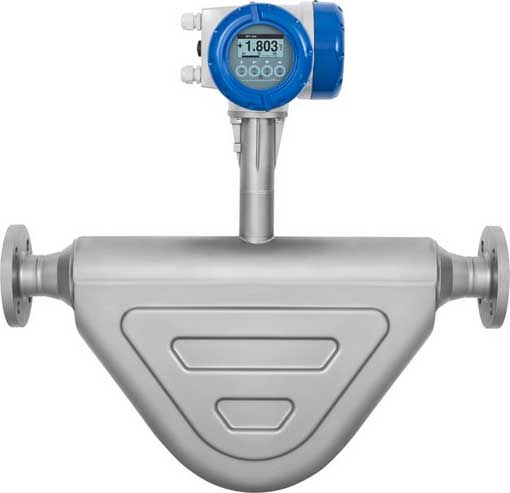What is a Coriolis Flow Meter and how does it work?
This type of flowmeter is based on the so-called Coriolis effect, named after the discoverer of this phenomenon, Gaspard-Gustave Coriolis. You travel on one of the meridians from the North Pole to the South Pole. Standing at the North Pole you rotate on your axis, but you have no rotational speed. During your journey from north to south, your own direction of motion is to the south, but due to the rotation of the earth, you get rotational speed up to a maximum of about 40,000 km/D.
Important.. when stationary there is no Coriolis force, but it does occur when the mass is moving. This phenomenon underlies the Coriolis mass flow meter.
Most Coriolis mass flow meters are based on 2 parallel tubes. These are attached to the flanges, and are vibrated by a coil positioned in the middle of the measuring tubes. The analogy with the trip around the world.. the two flanges are the north and south poles. The center of the tubes, where the greatest amplitude of the vibration occurs, is the equator. At 0-flow the tubes vibrate, but no Coriolis force occurs. The vibration of the tubes is then symmetrical. However, when mass flows through the measuring tubes, a reaction force does occur which, at a certain moment on the inflow side, is directed opposite to the other side. These forces cause the tubes to sway, out of phase. The phase shift is proportional to the mass flow. Coriolis flow meters are not speed meters, not volumetric flow meters, but mass flow meters.
During the measurement, the measuring tubes reach their natural frequency. This is linked to the mass of the measuring tubes, or the mass of the medium in the measuring tubes. Coriolis mass flow meters thus measure the density of the medium. In addition, each instrument has a built-in temperature sensor that measures the product temperature. All parameters, as well as the calculated volume (from mass flow and density) are available as a measurement signal or via possible serial communication.
The tubes pictured below are in an Omega shape. There are many forms. A U-shape, triangular, S-shape, corkscrew, trapezoid, tennis racket, and also straight shapes. And there are also single-tube instruments. Every shape has its advantages, and every shape also has its disadvantages. Making compromises in the design of a Coriolis mass flow meter is unavoidable.
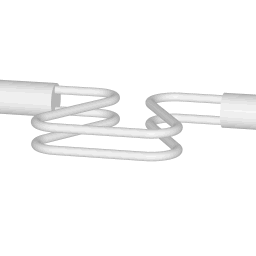
Oscillation without flow
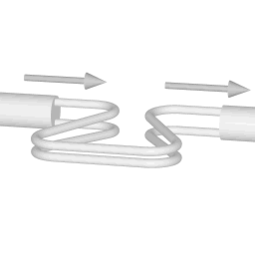
Oscillation with flow
A Coriolis mass flow meter measures the MASS flow. This alone distinguishes this measuring technique from most others. But another special thing is that each manufacturer has opted for a certain shape of the measuring tubes. And it's not that there is only one best form. Each form has its advantages and also limitations.
The U-tube, the S-shape, the Omega tubes, the paper clip, the tennis racket, the single-tube version, the straight single-tube and also the double straight tube, the corkscrew, the trapezoid, the triangle and all those other shapes. All flow meters measure the mass flow. And almost all instruments provide a useful density measurement signal.
Of course, a straight tube has the advantage that it is a straight tube, and that it is easy to clean. There are of course reasons why not everyone chooses this solution. From a mass measurement point of view, the Omega shape and triangle shape are superior. The disadvantage of this shape is (compared to other shapes) a less accurate density. The 'tennis racket version' generates the Coriolis forces a little differently than the rest. Some shapes are better used for high pressure applications. The corkscrew shape is originally a single-tube system, but the flowmeter is wide and therefore does not fit in the pipe system in some places. Expensive diversions in the pipework are not always a good option. A surprisingly good result can be achieved with the paperclip, but the process connections do not always come out nicely.
Modern instruments are often equipped with DSP (Digital Signal Processing). In this case, the real measurement signal is better isolated from the noise, which of course leads to an improved measurement result. 'Imperfection' in the flowmeter due to the shape of the measuring tubes are therefore somewhat obscured.
Overall, there are several ways to assess the performance of a Coriolis flowmeter. For each application, it must be determined which option is preferred. It may sound a bit strange, but the selection of a Coriolis mass flow meter is often based on a compromise.
Some images how to install a Coriolis meter
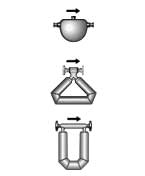
Process.. Liquids
prefered orientation
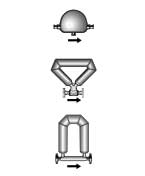
Process.. Liquids
alternate orientation
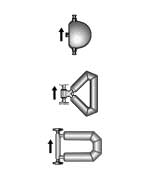
Process.. Liquids
alternate orientation

Process.. Gases
prefered orientation

Process.. Gases
alternate orientation
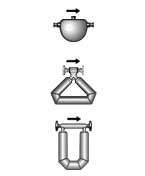
Process.. Gases
alternate orientation

Process.. Slurries
prefered orientation

Process.. Slurries
alternate orientation

Process.. Slurries
alternate orientation
Common Applications for Coriolis Flow Meters
Coriolis mass flow meters are used predominately in scientific applications where they measure both corrosive and clean gases and liquids. They are also used in..
- Pulp and paper processing
- Petroleum and oil
- Chemical processing
- Wastewater handling
Coriolis flow meters with a straight tube design are more easily cleaned so are preferred for food and beverage applications as well as pharmaceuticals. They can also handle the slurries typically found in mining operations.
